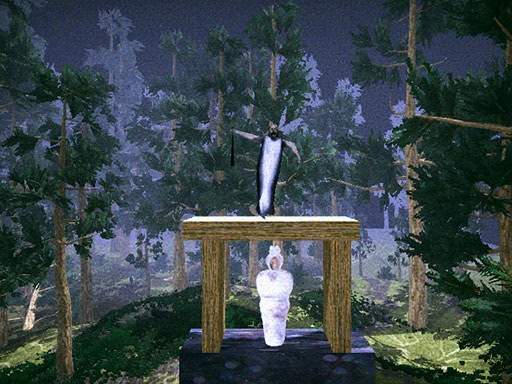
Pocong and Kuntilanak: Exploring Indonesia’s Haunted Legends 🕯️👻
A Glimpse into Indonesian Horror
Indonesia is rich in folklore, and few stories are as chilling as the Pocong and Kuntilanak. These spirits have haunted generations, and now they leap from myths into interactive horror gaming.
In this game, players face the supernatural: hopping Pocongs wrapped in burial shrouds and wailing Kuntilanaks lurking in shadows. The thrill comes from tension, sudden scares, and the challenge of surviving in a world where every corner might hide a ghost.
Understanding the Pocong
The Pocong is wrapped tightly in a white burial shroud, a ghost said to arise if burial rituals are incomplete. In the game, these spirits hop unpredictably, making every move a potential risk.
- Behavior: Erratic jumping and sudden appearances.
- Challenge: Players must anticipate movements to avoid capture.
- Symbolism: Reflects the deep-rooted belief in life after death and proper burial practices.
Dodging a Pocong requires attention and patience—jump too early, and you might get caught.
Meeting the Kuntilanak
The Kuntilanak is a female spirit with long hair and haunting cries. She’s known for appearing suddenly, often accompanied by eerie whispers or chilling visuals.
- Behavior: Stalks the player, appearing in unexpected locations.
- Strategy: Observing patterns is key—learn her behavior before advancing.
- Horror Element: Her wail signals danger, keeping players on edge.
The combination of both spirits ensures the game is never predictable, enhancing suspense.
How to Play: The Basics
Pocong and Kuntilanak uses a mouse-only control system, making it accessible yet tense.
- Move the cursor to navigate your character.
- Click to interact, hide, or trigger mechanisms.
- Observe carefully: Shadows and audio cues are your main allies.
Timing and observation are everything. Unlike fast-action games, horror thrives on anticipation.
The Art of Fear: Graphics and Sound
What makes the game truly immersive is its sensory design:
- Visuals: Dark, misty environments with subtle movements that trigger anxiety.
- Audio: Whispers, footsteps, and wails heighten tension.
- Lighting: Shadows conceal threats, making exploration nerve-wracking.
Every design choice amplifies the fear factor, creating a realistic horror experience.
Tips to Survive the Haunted Realm
To master this ghostly world, players should:
- Stay calm: Panicking leads to mistakes.
- Watch and listen: Both spirits give subtle cues.
- Plan movements: Don’t rush into dark areas blindly.
- Use hiding spots: Patience often saves more than speed.
- Learn patterns: Repeated encounters reveal behavioral tendencies.
Even a seasoned player will find themselves startled repeatedly—it’s part of the fun!
The Psychology Behind the Fear
Why do these spirits scare us so effectively?
- Anticipation: We fear what might appear next.
- Sound Cues: Wails and whispers trigger instinctive reactions.
- Visual Triggers: Shadows and sudden movements create a startle response.
Understanding these elements explains why Pocong and Kuntilanak feels terrifying yet addictive.
A Short Tale from the Game
Imagine this: you navigate a dim hallway, mouse cursor hovering. A sudden rustle—your heart races. A Pocong hops directly toward you. You freeze, then move cautiously, narrowly avoiding capture. Suddenly, a wailing Kuntilanak appears in a doorway. That split second between life and “game over” is pure adrenaline.
Moments like these keep players coming back—fear becomes thrilling, not just terrifying.
Humor Amidst Horror
Even in horror, laughter sneaks in.
- Accidentally bumping into a wall while fleeing a ghost.
- Misjudging a shadow and screaming at nothing.
- Friends watching you jump at your own reflection.
These lighthearted moments balance terror, keeping gameplay entertaining. 👻😅
Exploring Indonesian Folklore Through Gameplay
The game also educates players about local legends. Pocong and Kuntilanak have deep cultural roots, and their representation exposes players to mythology, rituals, and traditional fears.
- Cultural immersion: Learn about burial rituals and ghost stories.
- Storytelling: Every encounter hints at the spirit’s origin.
- Tradition meets technology: Folklore is experienced interactively.
It’s both thrilling and enlightening.
Designing Strategy: Observation vs. Reaction
In horror games, reaction alone won’t keep you alive.
- Observation: Watch for visual cues like movement in shadows.
- Patience: Rushing often triggers ghost encounters.
- Memory: Remembering previous spirit patterns helps anticipate threats.
Players who master these elements progress further and survive longer.
The Game’s Atmosphere
The immersive atmosphere is a core feature:
- Fog-covered paths
- Flickering lights
- Mysterious ambient sounds
These details make players feel “inside” the haunted environment. Every step is a tension-building moment.
Challenges for New Players
Beginners often struggle with:
- Sudden appearances of spirits.
- Misinterpreting audio cues.
- Navigating dark, confined spaces.
Patience and repeated practice lead to improvement—fear becomes manageable with experience.
Comparing Pocong and Kuntilanak with Other Horror Games
| Game | Style | Key Feature | Experience |
|---|---|---|---|
| Pocong and Kuntilanak | Indonesian folklore | Cultural horror, mouse-based | Eerie, suspenseful, educational |
| Five Nights at Freddy’s | Animatronic horror | Static camera, jump scares | High tension, nerve-wracking |
| Slender: The Arrival | Urban legend | Endless pursuit | Psychological horror, fear of the unknown |
| Granny | Escape horror | Stealth, traps | Tense, strategic |
Its unique cultural context sets it apart from Western horror games.
Why It Appeals to Global Players
Even without knowledge of the folklore, the game’s tension, suspense, and scares are universally compelling. Cultural specifics add depth, but fear is a universal emotion.
- Accessibility: Simple mouse controls.
- Replayability: Randomized spirit appearances.
- Immersive suspense: Keeps players engaged.
Stories Players Share
Players often recount near-misses, sudden jumps, and moments of sheer panic. One gamer shared: “I screamed so loud my cat ran out of the room! But I couldn’t stop playing.”
These shared experiences enhance the game’s community appeal.
Incorporating Humor in Horror Strategy
Oddly enough, laughter improves focus. Light-hearted breaks prevent panic, allowing players to recover and strategize more effectively.
- Pause to breathe.
- Joke about your own reactions.
- Play with friends and share scares.
It’s a balance of tension and release.
Tips for a Thrilling Experience
- Play in a quiet room for full immersion.
- Use headphones to catch every audio cue.
- Adjust sensitivity to avoid accidental clicks.
- Take short breaks to maintain alertness.
- Watch your surroundings—fear is amplified by imagination.
The Allure of Indonesian Horror
The cultural depth makes Pocong and Kuntilanak fascinating. Players explore beliefs, superstitions, and ghostly folklore while enjoying gameplay. This combination of thrill and education is rare.
- Learn about Pocong burial traditions.
- Understand Kuntilanak stories and origins.
- Experience horror rooted in authentic mythology.
Why Players Keep Coming Back
The game is addictive because:
- Each playthrough is unpredictable.
- Fear triggers adrenaline and excitement.
- Quick gameplay allows multiple attempts.
- Cultural storytelling enriches the experience.
Even after repeated scares, curiosity drives players forward.
Ready to Face the Spirits?
Are you brave enough to confront hopping Pocongs and wailing Kuntilanaks? With only your mouse as your guide, survival requires sharp reflexes, calm observation, and nerves of steel.
Enter the haunted world and experience Indonesian horror like never before. Just don’t be surprised if you jump at your own shadow… 👻🖱️
For Your Social
#PocongAndKuntilanak #IndonesianHorror #HorrorGaming #MouseControls #CulturalHorror #SpookyFun #FolkloreGaming




